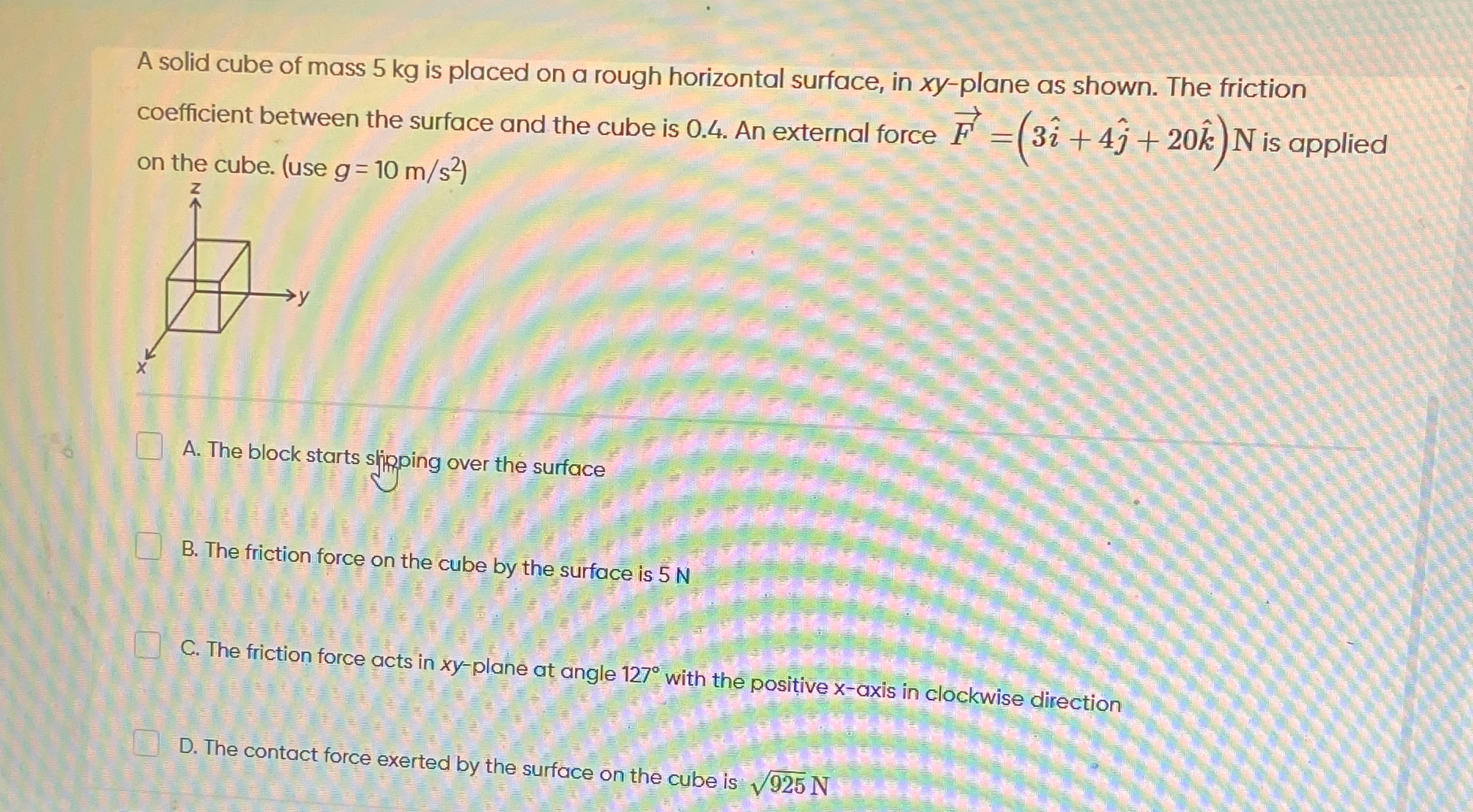Question
Question: A solid cube of mass 5 kg is placed on a rough horizontal surface, in xy-plane as shown. The frictio...
A solid cube of mass 5 kg is placed on a rough horizontal surface, in xy-plane as shown. The friction coefficient between the surface and the cube is 0.4. An external force F=(3i^+4j^+20k^) N is applied on the cube. (use g = 10 m/s²)

The block starts slipping over the surface
The friction force on the cube by the surface is 5 N
The friction force acts in xy-plane at angle 127° with the positive x-axis in clockwise direction
The contact force exerted by the surface on the cube is 925 N
B, C, D
Solution
-
Calculate Normal Force: The weight of the cube is W=mg=5 kg×10 m/s2=50 N (downwards). The applied force has a vertical component Fz=20 N (upwards). Since the cube is on a horizontal surface and not accelerating vertically, the normal force N is given by N+Fz=W. Thus, N+20 N=50 N, which gives N=30 N.
-
Calculate Applied Horizontal Force: The applied force is F=(3i^+4j^+20k^) N. The horizontal component of the applied force is Fxy=3i^+4j^ N. The magnitude of this horizontal force is Fxy=32+42=9+16=25=5 N.
-
Calculate Maximum Static Friction: The maximum static friction force is fs,max=μsN, where μs=0.4 is the coefficient of static friction. So, fs,max=0.4×30 N=12 N.
-
Check for Slipping: Since the applied horizontal force Fxy=5 N is less than the maximum static friction force fs,max=12 N, the block does not start slipping. Thus, option A is incorrect.
-
Determine Friction Force: As the block does not slip, the static friction force is equal in magnitude and opposite in direction to the applied horizontal force. The friction force is f=−Fxy=−(3i^+4j^)=−3i^−4j^ N. The magnitude of the friction force is ∣f∣=(−3)2+(−4)2=9+16=25=5 N. Therefore, option B is correct.
-
Determine Direction of Friction Force: The friction force vector is f=−3i^−4j^. This vector lies in the xy-plane. To find its angle with the positive x-axis, we can consider its components. Let θ be the angle measured counter-clockwise from the positive x-axis. Then tanθ=−3−4=34. Since both components are negative, the vector is in the third quadrant. The principal angle is arctan(4/3)≈53.13∘. The angle in the third quadrant is θ≈180∘+53.13∘=233.13∘. The angle measured clockwise from the positive x-axis is 360∘−233.13∘=126.87∘. This is approximately 127∘. Therefore, option C is correct.
-
Calculate Contact Force: The contact force exerted by the surface on the cube is the vector sum of the normal force and the friction force. The normal force is N=30k^ N (acting upwards). The friction force is f=−3i^−4j^ N. The contact force is Fcontact=N+f=30k^+(−3i^−4j^)=−3i^−4j^+30k^ N. The magnitude of the contact force is ∣Fcontact∣=(−3)2+(−4)2+(30)2=9+16+900=25+900=925 N. Therefore, option D is correct.
